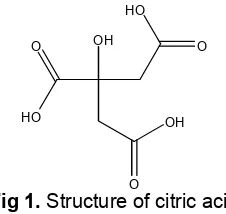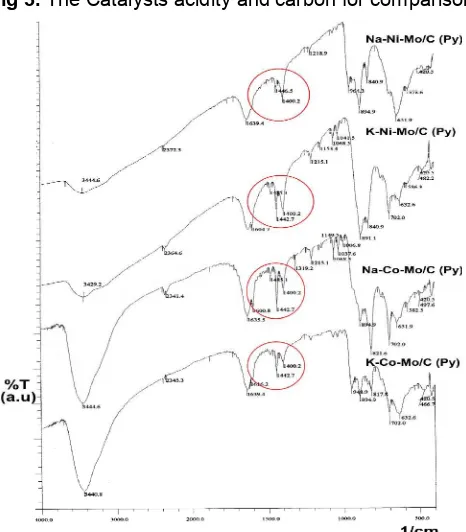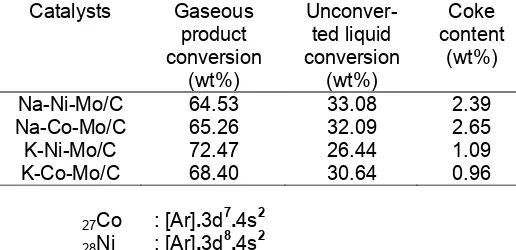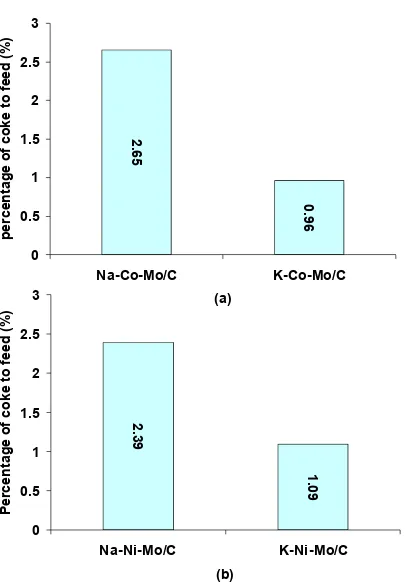* Corresponding author. Tel/Fax : 062-274-545188 Email address : wegatri @ugm.ac.id
SOL-GEL DERIVED Co AND Ni BASED CATALYSTS: APPLICATION FOR STEAM
REFORMING OF ETHANOL
Haryo Satriya Oktaviano and Wega Trisunaryanti*
Department of Chemistry, Faculty of Mathematics and Natural Sciences Gadjah Mada University, PO Box BLS 21 Yogyakarta, Indonesia 55281
Received 13 November 2007; Accepted 19 December 2007
ABSTRACT
Cobalt and nickel based catalysts for ethanol steam reforming have been prepared. Preparation of Na-Ni-Mo/C, Na-Co-Na-Ni-Mo/C, K-Ni-Mo/C and K-Co-Mo/C have been carried out using sol-gel method by applying citric acid as complexion agent and source for support formation. Prepared catalyst via sol gel showed tailored morphological properties signed by tailored pore size distribution. The acidity of catalyst showed that all catalysts contain only Lewis acid site. The catalyst activity test was conducted by using semi flow method with molar ratio of ethanol : water = 0.33 at 400 oC
Keywords:sol-gel method, steam reforming, ethanol
INTRODUCTION
The economic growth of modern industrialized society has been based on utilization of energy stored in fossil fuels: coal, petroleum, and natural gas. At present time, about 80% of the world energy demand is met by fossil fuels. Fossil fuels are storable and portable, which make them excellent fuels for transportation.
However, the need for higher efficiencies (in order to have more energy services with less energy resources) and concerns about the environment, together with diminishing reserves of fossil fuels promote a growing and general interest for rational use of renewable energy resources and in particular of bio-energy. Renewable energy technologies could significantly contribute to solve the problems of energy supply, environmental protection and regional development. One of them is fuel cell. Fuel cell technology is indisputably an ultra-clean method for generating electricity for mobile and stationary applications. Fuel cell operates by electrochemical oxidation of hydrogen generating electricity while forming water as the product. Hydrogen is the only practically useful fuel for generation of fuel cells. The main reason is its high electrochemical reactivity compared with conventional fuels like natural gas, coal naphtha and alcohols, from which it is often produced. That is why providing the hydrogen required by the fuel cell to generate electricity is a challenging task associated with fuel cell applications.
Conversion of liquids with high hydrogen to carbon ratio, such as primary alcohols, is possible at relatively low temperatures and sought of by the automotive industry as one of the most promising solution for generating the hydrogen on board the automobile [1]. One of the best ideas is applying steam reforming of alcohol. There have been some earlier studies of this kind of reaction, concerned with steam
reforming of methanol and ethanol. From an environmental point of view, ethanol is preferred to methanol since ethanol is much less toxic and it can be considered as a renewable raw material easily obtained from biomass by fermentation processes [2]. The steam reforming of ethanol can be shown in chemical reaction equation below:
C2H5OH (g)+ 3H2O (g) 6H2 (g)+ 2CO2 (g)
ΔHo = 173 kJ mol-1
Al-Qahtani stated that elements of group VIII (Fe, Co, Ni, Rd, Ru, Pd, Os, Ir and Pd) were active for steam reforming [3]. Considering the candidates for catalyzing the reaction was enormous, the researchers started to investigate which elements will be more valuable for the application, especially for the catalyst performance it self and also operational cost. From this point of view, many papers dealing with ethanol steam reforming have been published up to now [2, 4-5], and most of them used cobalt or nickel catalyst. Considering the biggest challenge from this typical reaction is coke deposition, Grzegorczyck et al. applied molybdenum for nickel-based catalyst. They reported that Mo caused a significant increase in resistance to
coking of nickel catalyst on α-Al2O3 [6]. Cheng has also
reported that alkali metals can decrease the activity of the dehydration of methanol, which promotes carbon deposition onto catalyst [7].
Sol-gel method provides many advantages, for example possibility to control their microstructure and homogeneity, but the studies about catalyst preparation using cobalt and nickel by sol-gel method have not got any enough attention [8].
EXPERIMENTAL SECTION
Materials
Chemical reagents used in this research were (NH4)6Mo7O24 (Merck, 98%), Co(NO3)2.6H2O (Merck,
99%), Ni(NO3)2.6H2O (Merck, 99%), Citric acid (GPR,
99.5%) GPR, Formic acid (Merck, 37%), K2CO3 (Merck,
99.9%), Na2CO3 (Merck, 99.9%), ammonia (Merck,
25%), ethanol (Merck, 99.8%), aquabidest (PT Ikapharmindo Putramas), pyridine (Merck, 99%), nitrogen gas (technical grade, PT Samator Gas), oxygen gas (technical grade, PT Samator Gas), glass wool, kitchen salt.
Instrumentation
Instruments used in this research were glass equipments, electrical heater, electrical oven, porcelain crucibles, 100-mesh sieve (RX86), analytical scale (Digital Mettler AE100), desiccators, vacuum pump, regulator, thermocouple, a set of reactor, tube furnace, digital thermometer (Termolyne), thermometer, flow meter, pelletizer, water cooling system.
Determination of catalyst specific surface area, total pore volume, average pore radius and pore size distribution was based on adsorption phenomena which developed by Brunauer, Emmet and Teller (BET). The measurement was conducted by using Gas Sorption Analyzer NOVA-1000 in The Center of Research and Advance Technology Development (P3TM) BATAN Yogyakarta.
Procedure
Catalysts Preparation by Using Sol-gel Method (K-Co-Mo/C)
The preparation of catalyst adopted from [9] was as follows: firstly, 20 mL of 0.5 M cobalt and 20 mL of 1 M molybdenum aqueous solutions were prepared separately and then mixed. Citric acid solution was added to the solution under constant stirring (0.6M citric acid, 20 mL). Finally, kalium solution was dropped slowly into the solution (0.1 M potassium ions, 20 mL). The pH value of the mixed solution adjusted to 3.5 by using HCOOH and NH4OH. The solution kept in water bath at
65 oC until the solution became a gel. During the gelation process, the solution kept homogeneous and no precipitation formed. The as-prepared gel dried at 120
o
C for 15 h and calcined under nitrogen gas stream at 400 oC for 4 h.
Preparation of Na-Co-Mo/C, K-Ni-Mo/C and Na-Ni-Mo/C were conducted by changing the metal solutions with the appropriate one(s).
Determination of Catalyst Acidity
The acidity was determined quantitatively by gravimetric method using pyridine adsorption. The acidity of catalyst (mmol pyridine/gram catalyst) was originally calculated by comparing the weight of catalyst
after and before contacted with pyridine for 24 h and was stated with the equation:
12 0
1W W
Acidity 1000
W W / M
After adsorbing pyridine, catalysts were analyzed by Infra red spectrometry (pellet method) using FT-IR spectrometer (Shimadzu-8201PC).
Catalytic Activity Testing
Catalytic activity testing was conducted for all provided catalysts by using semi flow method with weight ratio of catalyst to feed of 1/10. Catalyst was taken and put into catalyst container. This catalyst container was placed into the reactor tube connected to feed container and cooler system. Feed (ethanol solution, where ethanol/water molar ratio = 0.33) was put into feed container made from three-necked round flask. One neck was connected to reactor tube, one for thermometer and the other for streaming nitrogen gas. Cooler system contained cooler tube connected with liquid sample-collecting flask and the last is gas trap for trapping all gas produced from reaction.
Testing procedures were begun by heating the reactor tube until 400 oC. After the temperature was stabilized, feed container was heated by using electrical heater. Then, nitrogen was flowed into feed container under flow velocity at 10 mL/min. This system was kept until all feed soaked up liquefiable gaseous products condensated in cooler tube and flowing along this tube until reaching sample-collecting flask then was weighed as unconverted liquid (wt%).
Determination of Coke Formation
Coke formation was determined by oxidizing used catalyst with oxygen gas at temperature 500 oC for one hour. After oxidation process, there was a weight decrease of sample, which it means that deposited coke has been already oxidized. From the difference between fresh and used catalyst weight, we calculated the coke content on the surface of catalyst.
If unconverted liquid conversion and coke content was already known, so gaseous product conversion was estimated from the formula below [10]:
Gaseous product conversion
100 unconverted liquid coke content %
RESULT AND DISCUSSION
Preparation of Catalysts Using Sol-Gel Method
OH O
Fig 1. Structure of citric acid
In the sol-gel method, there are two main reactions, which are hydrolysis (sol formation) and condensation (gel formation). The reactions were proposed by Bao et al. [9] for K-Co-Mo/C. They reported that citric acid reacted with cobalt ions to form cobalt citrate (Co(OOCR)2 ) and prevented the co-precipitation
between Co and Mo. Then under appropriate conditions, the cobalt citrate hydrolyzed and formed sol [9]. The sol-gel chemistry can be described as below:
Hydrolysis: viscosity caused by particles aggregation and condensation [11]. In our work, gel formation occurred after the sol was kept in water bath at 65 oC.
Based on the explanation before, so we propose that the sol-gel chemistry for Nickel based catalyst via nickel citrate formation for preventing the co-precipitation between Ni and Mo, and the reactions are:
Hydrolysis:
Ni(OOCR)2 + xH2O Ni(OOCR)2-x(OH)x + xRCOOH Condensation:
Ni(OOCR)2-x(OH)x (OH)x-1(OOCR)2-xNi)2 + H2O
Whether the formation of Mo-citrate also happened or not, still not clear. By assuming the ionic radii of Ni and Co are bigger than Mo, so the probability of nickel citrate and cobalt citrate formation is higher than molybdenum citrate. That is why, the proposed reactions in sol-gel chemistry stated like above.
The obtained catalysts are Na-Ni-Mo/C, Na-Co-Mo/C, K-Ni-Mo/C and K-Co-Mo/C. Carbon as support of catalyst was known as carbon xerogel because the solid product was prepared by conventional drying method, rather than supercritical method. Conventional drying method actually has bad impact into the shrinkage of the initially uniform body, but this can be controlled by applying the appropriate heat in the gel drying process [11-12].
Pore Analysis for Solid Catalysts
Prepared catalysts were supported to carbon xerogel that derived from drying and calcinations of
Table 1. Data for specific surface area, total pore results of pore analysis are shown in Table 1.
The potential advantages of sol-gel method include: purity, homogeneity and controlled porosity combine with the ability to form large surface are material at low temperature [13]. In order to test whether the sol-gel approach is more valuable in producing tailored morphological properties or not, we can see from many aspects in pore analysis data.
Table 1 shows that specific surface area of materials quite large for first trial, even so the value for all catalysts are not same. From the data, we can figure out that the specific surface area for Ni-Mo/C, Na-Co-Mo/C and K-Na-Co-Mo/C are quite same.
The biggest difference comes from K-Ni-Mo/C, which shows the largest specific surface area from them (around 5 m2/g differs with the others). The same conditions also shown from total pore volume, here also can be seen that three explained catalysts before have similar total pore volume and again, for K-Ni-calcinations steps. Because even we kept at the same temperature and gas flow velocity, but if the heating rate was not same, it would promote to different in shrinkage velocity and also rearrangement. The rearrangement factor, can be used to describe the phenomenon in K-Ni-Mo/C. We assumed that the metals highly dispersed on the surface of carbon, rather than blocking the pore opening mouth. Similar explanation also was reported by Rahiem for Co-Mo/ZnO with the largest specific surface area, and the biggest total pore volume but followed by the little average pore radius among the series of catalysts [10].
0
so the last step is by looking at the pore size distribution (PSD) curve among the catalysts (Fig 2). A PSD curve is become important tool because it represents the cumulative fraction of total pore volume within catalyst samples made up by particular range of pore sizes.
From the PSD curve below it can be depicted that there is a tailored distribution among the pores size of catalysts. This tailored morphological property shows that sol-gel method successfully proven to prepare materials with controlled porosity. Fig 2 also indicates that the pore size classified as mesopore, with range of pore size diameter is greater than 20 Å (or 2 nm) [14]. Pore size itself defines an ability of the reactant molecules to penetrate inside the particle and interact with its inner surface. This is especially important because the ratio of the outer particle surface to its inner one is so little, that is why the surface molecular interaction mainly occurs on the inner particle surface.
Acidity of Catalyst
Acidity test was conducted to determine the amount of acid sites on the catalysts. High in acidity means large number of acid site on the catalysts. The acidity was measured by applying gaseous base adsorption, with pyridine as the gaseous base. Adsorption process occurred in the closed system dessicator, where samples were placed and also a crucible contained pyridine inside of it. Let the pyridine vaporized by it self, and interacted with the sample for at least 24 h. Hopefully this period is already enough to make the entire acid sites interacted with the pyridine and adsorbed in the catalyst. The result of acidity test can be shown in Fig 3.
Fig 3 shows that acidity of carbon (prepared by heating and calcination of citric acid at 400 oC) and catalysts, prepared by sol-gel method quite different. The acidity of carbon is lower than all catalyst samples. This is because transition metals, which dispersed on the carbon support, have unfulfilled orbitals, presumably effective as electron pair(s) acceptor from the base adsorbate. According to Bell, the surface of metal oxides is comprised predominantly of oxygen atoms, hydroxyl groups, and metal atoms [15]. Oxygen anions behave as Lewis base, metal cations behave as Lewis acids, and hydroxyl groups can act as either acids or bases. The characteristic of acidity depends on the nature of the oxide, charge and radii of metal ion, the characteristic of metal oxygen bonding, and the availability of unfulfilled d orbitals.
If we compare between Ni based catalyst (Na-Ni-Mo/C and K-Co-(Na-Ni-Mo/C) and Co based catalysts (Na-Co-Mo/C and K-Co-(Na-Co-Mo/C), it is showed that the acidity of Co based catalysts are higher than Ni based catalyst. This is presumably happened because the availability of unfulfilled dorbital in cobalt are more than nickel.
Fig 2. Pore size distribution curves among the catalysts
1
C Na-Ni-M o/C Na-Co-Mo/C K-Ni-Mo/C K-Co-Mo/C Samples
Fig 3. The Catalysts acidity and carbon for comparison
Table 2. Results from steam reforming reaction of prepared catalysts, by using FT-IR spectroscopy on the pyridine-adsorbed catalysts (Fig 4). The kind of acid sites on the catalysts is Lewis type. This can be proven by the absence of band at 1,540 cm-1, which is due to pyridinium ion formed by adsorption of pyridine on Bronsted acid sites [16]. Fig 4 shows that the bands at the red circle area are characteristics bands of pyridine coordinately bonded to Lewis acid sites.
Table 2 shows that steam reforming of ethanol catalyzed by our prepared catalyst produces gaseous product higher than 50 % for all catalysts. Coke conversion is not so high, around 3% for Na promoted catalysts and 1% for K promoted catalysts. Data in table 2 also shows that the gaseous product is higher than unconverted liquid conversion. This result indicated that our prepared Co based catalysts and Ni based catalysts via sol-gel method are good enough for gas production under steam reforming of ethanol. From the catalytic activity test, it also can be seen that dominant product is only gaseous product. It causes the activity of catalyst, predominantly investigated by looking at the gaseous product percentage.
The future application for this research is hydrogen generation from waste material of sugar factory called fusel oil, which the main components are isoamyl alcohol, ethanol and water. Produced hydrogen then used as fuel for Fuel cell system. In this research, the components of gaseous product have not been analyzed yet, but the big percentage of gaseous product from steam reforming of ethanol is a good indication for a previous work in catalysts preparation in this field like the author did.
If we further look at the data for sodium promoted catalyst, Na-Ni-Mo/C and Na-Co-Mo/C can be seen that the gaseous product conversion is not so different. This could be happened presumably because the pore analysis characters, which slightly different among them. Similarity on pore characters, like specific surface area and total pore volume will effect on the catalytic performance it self. Specific surface area and total pore volume tightly related with gaseous product conversion because getting larger specific surface area, the
available places for interaction on the surface of catalysts also getting larger. It means the possibility for adsorption, interaction of reactant(s) and also dissociation of product(s) are increasing too [17]. From this series of catalyst, moreover can be drawn a fact that the performance in gaseous production of cobalt and nickel as main metal catalyst are not so different (regarding both of catalysts have similar pore characters and a slightly different acidity), this result agreed with research conducted by Benito et al. [18]. From their results, nickel and cobalt catalyst showed same 100% ethanol conversion and high selectivity to hydrogen (70%) at 700 oC. The different laid on the stability of catalyst, where cobalt showed excellent stability after 60 h in operation. This result also supported from the data of potassium promoted catalysts, where the only slightly different gaseous product conversion was occurred between K-Ni-Mo/C and K-Co-Mo/C. This kind of difference might be arisen from the larger specific surface area of K-Ni-Mo/C promoter and Na promoter to the catalysts was studied by dividing the catalysts into two groups. The first group was Co based catalysts and the second was Ni based catalysts. For each group would be investigated the relationship between, the type of promoters and the coke formation (derived from oxidation experimental).
From the Fig 5, it can be seen that for Na promoter always shows higher coke formation than that of K promoter either for Co based catalyst or Ni based catalysts. This phenomenon can be explained using dipole formation theory that suggested by Chorkendorff and Niemantsverdriet [19].
2 formation: (a) cobalt based catalyst and (b) nickel based catalyst
Fig 6. Scheme of dipole formation by Chorkendorff and Niemantsverdriet [19]
Fig 6 shows that potassium deposited on a surface. The potassium sets up a dipole field, which may interact with adsorbed species and molecules in transition states. With the dipoles of methane are in the same decreases. Sodium, which located on the third period, is getting more difficult to release the electron compare with potassium in fourth period. By decreasing the ability to form dipole, the ability to repel unwanted adsorbates
also decreases. That is why, the percentage of coke to feed for Na promoter is higher than K promoter.
11Na : [He].3s
While Benito et al. also reported the possibility of coke deposition via ethanol dehydration to produce ethylene. Ethylene follows further reaction to promote coke [18]. presence of sodium could inhibit coke deposition on the catalyst surface. As explained above, we proposed that sodium also forms dipoles and induced dipoles will be used for repelling unwanted adsorbates, which promote carbon formation. Of course, the ability of Na for dipoles formation is less than K.
CONCLUSION
A sol-gel method can be applied for steam reforming of ethanol catalysts preparation, by applying citric acid as a complexing agent and a carbon source for support formation. Catalysts derived from sol-gel method showed tailored morphological properties signed by tailored pore size distribution among the catalysts. Cobalt and nickel catalyst showed quite same performance in steam reforming ethanol, the little differences laid in the gaseous product conversion can be explained from the pore characteristic and acidity of catalyst. Promoting catalysts with alkali metals was inhibiting carbon (coke) deposition by dipole formation and dipole repulsion mechanism. K promoter shows higher ability to inhibit coke formation than that of Na promoter.
ACKNOWLEDGEMENT
The first author is grateful to SPACE program, Saga University, Japan and Prof. Nakashima Kenichi for giving an opportunity to go to Japan and gave me huge accessible information about this research.
REFFERENCES
1. Lindstrom, B., Agrell, J., and Petterson, L.J., 2003, Chem. Eng. J., 93, 91-101.
2. Freni, S., Cavallaro, S., Mondello, N., Spadaro, L., and Frusteri, F., 2003, Catal. Commun., 4, 259-268. 3. Al-Qahtani, H., 1997, Chem, Eng. J., 66, 51-56. 4. Llorca, J., Homs, N., Sales, J., Fierro, J.L.G., and de
la Piscina, P. R., 2002, J. Catal., 209, 306-307. 5. Batista, M.S., Santos, R.K.S., Assaf, E.M., Assaf,
J.M., and Ticianelli, E.A., 2004, J. Power Sources, 134, 27-32.
6. Grzegorczyk, W., Denis, A., and Borowiecki, T., 2002, Catal. Commun., 3, 293-297
7. Cheng W.H., 1999, Acc. Chem. Res., 32, 685-691. 8. Schubert, U., Schwertfeger, F., Gorsmann, C., 1996,
“Sol-Gel Materials with Controlled Nanoheterogeneity” in Nanotech Molecularly Design Materials, ed. Chew, G.M., ACS symposium series, ACS, Washington.
9. Bao, J., Fu, Y.L., Sun, Z.H., and Go, C., 2003, Chem. Commun., 746-747.
10. Rahiem, F., 2005, Preparasi dan Karakterisasi Katalis CoMo/ZnO untuk Konversi Isoamil alkohol dengan Metode Steam Reforming, undergraduate thesis, FMIPA UGM, Yogyakarta.
11. Schubert, U., and Husing, N., 2000, Synthesis of Inorganic Materials, Wiley-VCH, Weinheim.
12. Zanto, E.J., Al-Muhtaseh, S.A., and Ritter, J.A., 2002, Ind. Eng. Chem. Res., 41, 3151-3162.
13. Gonzales, R.D., Lopez, T., and Gomez, R., 1997, Catalysts, Catal. Today, 35, 293-317.
14. Hodnett, B.K., 2000, Heterogeneous Catalytic Oxidation, John Wiley and Sons Ltd., Chichester. 15. Bell, A.T., 1987, “Supports and Metal-Support
Interactions in Catalyst Design” in Catalyst Design: Progress and Perspectives ed Hegedus, L.L., John wiley and Sons Inc., New York.
16. Tanabe, K., 1981, “Solid Acid and Base Catalysts” in Catalysis Science and Technology ed Anderson, J.R., and Boudart, M., vol. 2, Springer-Verlag, Berlin.
17. Trisunaryanti, W., 2005, Preparasi, Karakterisasi dan Uji Aktivitas Katalis Nb2O5-ZAA dan Ni-Pd/Nb
2-O5-ZAA untuk Konversi Amil Alkohol menjadi
Hidrokarbon, Prosiding Seminar Nasional Kimia XVI ”Pengembangan Ilmu pengetahuan dan Teknologi Berbasis Ilmu Bahan: Pendekatan Teori dan Praktek”, Yogyakarta
18. Benito, M., Sanz, J.L., Isabel, R., Padilla, R., Arjona, R., and Daza, L., 2005, J. Power Sources, 151, 11-17.
19. Chorkendorff, I., and Niemantsverdriet, J.W., 2003, Concepts of Modern Catalysis and Kinetics, first edition, Wiley-VCH, Weinheim.
20. Niemantsverdriet, J.W., 2000, Spectroscopy in Catalysis, An introduction, second edition, Wiley-VCH, Weinheim.
21. Mas, V., Kipreos, R., Amadeo, N., and Laborde, M., 2006, Int. J. Hydrogen Energy, 31, 21-28. 22. Llorca, J., Homs, N., Sales, J., Fierro, J.L.G., and



